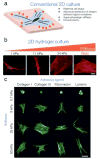A practical guide to hydrogels for cell culture
- PMID: 27123816
- PMCID: PMC5800304
- DOI: 10.1038/nmeth.3839
A practical guide to hydrogels for cell culture
Abstract
There is growing appreciation of the role that the extracellular environment plays in regulating cell behavior. Mechanical, structural, and compositional cues, either alone or in concert, can drastically alter cell function. Biomaterials, and particularly hydrogels, have been developed and implemented to present defined subsets of these cues for investigating countless cellular processes as a means of understanding morphogenesis, aging, and disease. Although most scientists concede that standard cell culture materials (tissue culture plastic and glass) do a poor job of recapitulating native cellular milieus, there is currently a knowledge barrier for many researchers in regard to the application of hydrogels for cell culture. Here, we introduce hydrogels to those who may be unfamiliar with procedures to culture and study cells with these systems, with a particular focus on commercially available hydrogels.
Conflict of interest statement
The authors declare no competing financial interests.
Figures


References
-
- Baker BM, Chen CS. Deconstructing the third dimension – how 3D culture microenvironments alter cellular cues. Journal of Cell Science. 2012;125:3015–3024. This review elegantly discusses the critical factors such as adhesion, mechanics, and nutrient transport that make 3D cultures different from cell experiments on 2D substrates. - PMC - PubMed
-
- Lutolf MP, Hubbell JA. Synthetic biomaterials as instructive extracellular microenvironments for morphogenesis in tissue engineering. Nat Biotechnol. 2005;23:47–55. - PubMed
Publication types
MeSH terms
Substances
Grants and funding
LinkOut - more resources
Full Text Sources
Other Literature Sources

